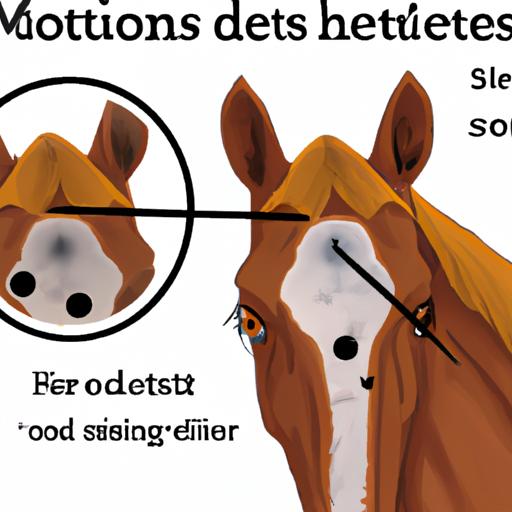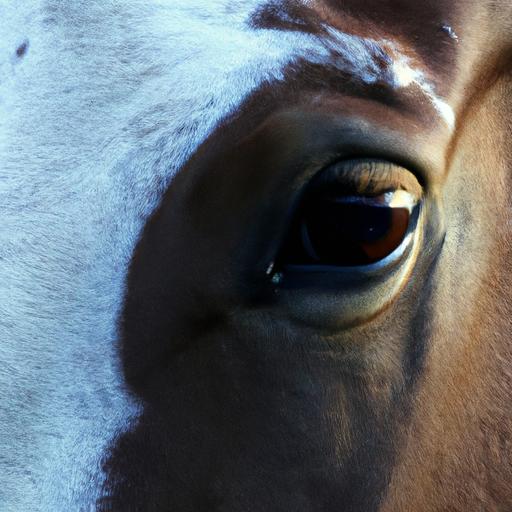Discover the causes, prevention, and management strategies for white spots on a horse’s eye. Learn how regular exams and prompt treatment can ensure equine eye health.
White Spot on Horse’s Eye: The eyes are windows to the soul, and this holds true for our equine companions as well. When it comes to the health and well-being of horses, it’s crucial to pay attention to every aspect, including their eyes. One concerning issue that horse owners may come across is the presence of white spots on their horse’s eyes. In this article, I will shed light on the significance of identifying and understanding these white spots, as well as explore the common causes behind them.
A. Definition of white spot on a horse’s eye
A white spot on a horse’s eye refers to a localized area of discoloration, appearing as a white or light-colored patch on the surface of the eye. These spots can vary in size and shape and are often noticeable to the naked eye. While some spots may be harmless, others can indicate underlying health conditions that require immediate attention.
B. Importance of identifying and understanding white spots on horse’s eyes
Understanding the significance of white spots on a horse’s eyes is paramount as they can serve as early warning signs of potential issues. By recognizing these spots, horse owners can take proactive measures to ensure the well-being and comfort of their beloved companions. Early detection can also play a crucial role in preventing further complications and minimizing the impact on the horse’s vision.
C. Common causes of white spots on horse’s eyes
Several factors can contribute to the formation of white spots on a horse’s eyes. One common culprit is equine recurrent uveitis (ERU), also known as moon blindness, which is a recurring inflammation of the inner eye structures. Corneal ulceration, cataracts, conjunctivitis, and various eye infections or injuries can also lead to the appearance of white spots. Each condition requires specific treatment and management approaches, making accurate diagnosis vital.
Now that we have a solid understanding of what white spots on a horse’s eye entail and their significance, let’s delve deeper into the symptoms and diagnostic procedures in Section 2. Remember, your horse’s eyes are a gateway to their world, and by understanding these white spots, you can ensure their continued well-being and happiness.
Symptoms and Diagnosis

When it comes to the well-being of our equine companions, understanding the symptoms and diagnosis of white spots on a horse’s eye is crucial. By being aware of the visual appearance of these spots, recognizing any associated behavioral changes or discomfort, and seeking veterinary examination and diagnostic procedures, we can ensure prompt and appropriate care for our horses.
A. Visual appearance of white spots on a horse’s eye
White spots on a horse’s eye can manifest in various forms. They may appear as small, distinct patches, or they can cover a larger area on the eye’s surface. These spots can range in color from a bright white to a pale yellow or grayish hue. It’s essential to observe any changes in size, shape, or intensity of these spots, as they can provide valuable insights into the underlying condition.
B. Behavioral changes or discomfort associated with white spots
While visual appearance is an important indicator, it’s equally crucial to pay attention to any behavioral changes or signs of discomfort that your horse may exhibit. A horse with white spots on its eye may frequently squint, blink excessively, or show sensitivity to light. They may also experience redness, tearing, or discharge from the affected eye. Any changes in behavior, such as rubbing the eye against objects or avoiding bright sunlight, should be considered red flags that warrant immediate attention.
C. Veterinary examination and diagnostic procedures
When white spots are observed on a horse’s eye, it is crucial to consult a veterinarian promptly. A thorough examination will be conducted to assess the condition of the eye and identify the underlying cause. Veterinary diagnostic procedures may include visual inspection, fluorescein staining to detect corneal ulcers, tonometry to measure eye pressure, and further tests like ocular ultrasound or blood work if deemed necessary. It is important to rely on the expertise of a veterinarian to ensure accurate diagnosis and appropriate treatment.
By being vigilant about the visual appearance, observing any behavioral changes or discomfort, and promptly seeking veterinary examination and diagnostic procedures, we can provide the best possible care for our horses’ eyes. In the next section, we will explore the common conditions that can lead to the formation of white spots on a horse’s eye. Stay tuned to expand your knowledge and ensure the well-being of your beloved equine companion.
Common Conditions Causing White Spots

When it comes to white spots on a horse’s eye, there are various underlying conditions that can be responsible for their appearance. Understanding these common conditions is crucial in order to provide appropriate care and treatment for your equine companion.
A. Equine Recurrent Uveitis (ERU)
Equine recurrent uveitis, also known as moon blindness, is a chronic condition characterized by recurrent inflammation of the inner eye structures. It is one of the leading causes of white spots on a horse’s eye. ERU can be triggered by a variety of factors, including autoimmune responses, infections, or even genetic predisposition. Prompt veterinary intervention is essential to manage this condition effectively and prevent further damage to the eye.
B. Corneal Ulceration
Corneal ulceration refers to the erosion or ulceration of the cornea, the transparent layer covering the front of the eye. This condition can result from trauma, foreign objects, or infections. Corneal ulcers can cause discomfort and may lead to the formation of white spots on the affected area. Timely treatment, including medication and protective measures, is crucial to prevent complications and promote healing.
C. Cataracts
Cataracts are characterized by the clouding of the eye’s lens, leading to visual impairment. While they are more commonly associated with aging, cataracts can also occur in younger horses due to genetic factors or trauma. The formation of white spots can be observed within the cloudy area of the lens. Surgical intervention may be necessary in severe cases, but regular monitoring and management can help slow down their progression.
D. Conjunctivitis
Conjunctivitis, commonly known as pink eye, is an inflammation of the conjunctiva, the thin membrane covering the white part of the eye. It can be caused by infections, allergies, or irritants. Conjunctivitis can lead to the appearance of white spots due to the inflammation and discharge present. Proper veterinary diagnosis and treatment are essential to alleviate discomfort and prevent further complications.
E. Other Eye Infections or Injuries
In addition to the aforementioned conditions, various other eye infections or injuries can result in the formation of white spots on a horse’s eye. These can include bacterial or viral infections, scratches, foreign bodies, or even exposure to harsh environmental conditions. Timely veterinary intervention and appropriate treatment are crucial in managing these conditions effectively and preserving the horse’s ocular health.
By familiarizing yourself with these common conditions that can cause white spots on a horse’s eye, you can better understand the potential underlying causes and seek appropriate veterinary care. In the next section, we will explore the available treatment options for managing these conditions and ensuring the well-being of your equine companion.
Treatment Options

When it comes to addressing white spots on a horse’s eye, various treatment options are available to alleviate discomfort, manage underlying conditions, and promote healing. The appropriate course of action will depend on the specific cause and severity of the white spots. Let’s explore some common treatment approaches:
A. Medications for managing uveitis or infections
In cases where white spots are caused by conditions like equine recurrent uveitis (ERU) or eye infections, medications play a crucial role in managing the underlying issues. Anti-inflammatory drugs, such as corticosteroids, may be prescribed to reduce inflammation and control the symptoms associated with uveitis. Antibiotics or antiviral medications might be administered to combat infections, promoting healing and preventing further complications.
B. Surgical interventions for severe cases
In more severe cases, surgical interventions may be necessary to address white spots on a horse’s eye. Corneal ulcerations or cataracts, for example, might require surgical procedures to repair or remove the affected tissues. These interventions are typically performed by skilled veterinary ophthalmologists who specialize in equine eye care.
C. Supportive care and preventive measures
Supportive care and preventive measures play a vital role in managing white spots on a horse’s eye and maintaining overall eye health. This includes providing a clean and dust-free environment to reduce the risk of eye irritations and infections. Regular eye examinations by a qualified veterinarian are essential for early detection and prompt treatment of any developing issues. Additionally, following proper hygiene practices, such as gentle cleaning of the eye area and avoiding the use of harsh chemicals, can help prevent further complications.
It’s important to consult with a veterinarian to determine the most appropriate treatment plan for your horse’s specific condition. By combining medical interventions with supportive care and preventive measures, you can optimize the chances of successful treatment and ensure your horse’s eye health remains in optimal condition. Now, let’s move on to Section 5, where we will explore prevention and management strategies to safeguard your horse’s eyes.
Conclusion
In conclusion, understanding and addressing white spots on a horse’s eye is paramount for the overall health and well-being of our equine companions. By recognizing the significance of these spots and their potential underlying causes, we can take proactive measures to ensure the comfort and vision of our horses.
Regular eye examinations and proper horse care routines play a pivotal role in preventing and managing white spots. By scheduling routine check-ups with a trusted veterinarian, we can detect any abnormalities early on and address them promptly. Additionally, incorporating proper hygiene practices and maintaining a clean environment can minimize the risk of eye infections and injuries that may lead to white spots.
Early detection and prompt treatment are essential when it comes to managing white spots on a horse’s eye. Timely intervention can prevent further complications and preserve the horse’s vision. Remember, the eyes are delicate organs, and any signs of discomfort or abnormalities should never be ignored.
At Horsemasterypro.com, we prioritize the well-being of horses and advocate for diligent eye care. By staying informed and proactive, we can ensure our horses lead healthy and fulfilling lives. So, let’s commit to providing the best care for our equine friends and safeguard their precious eyesight.
Remember, your horse’s eyes are their connection to the world, and by taking the necessary steps to prevent and manage white spots, we can ensure they see the world in all its vibrant glory.


